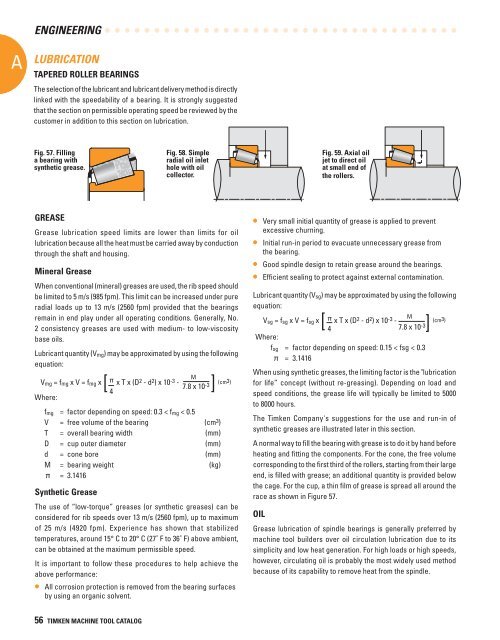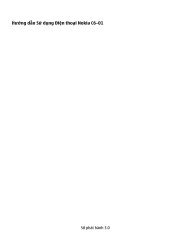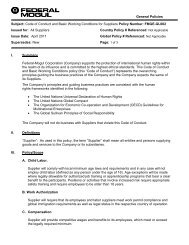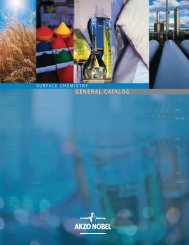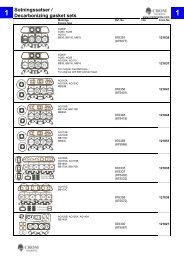You also want an ePaper? Increase the reach of your titles
YUMPU automatically turns print PDFs into web optimized ePapers that Google loves.
ENGINEERING<br />
A<br />
LUBRICATION<br />
TAPERED ROLLER BEARINGS<br />
The selection of the lubricant and lubricant delivery method is directly<br />
linked with the speedability of a bearing. It is strongly suggested<br />
that the section on permissible operating speed be reviewed by the<br />
customer in addition to this section on lubrication.<br />
Fig. 57. Filling<br />
a bearing with<br />
synthetic grease.<br />
Fig. 58. Simple<br />
radial oil inlet<br />
hole with oil<br />
collector.<br />
Fig. 59. Axial oil<br />
jet to direct oil<br />
at small end of<br />
the rollers.<br />
GREASE<br />
Grease lubrication speed limits are lower than limits <strong>for</strong> oil<br />
lubrication because all the heat must be carried away by conduction<br />
through the shaft and housing.<br />
Mineral Grease<br />
When conventional (mineral) greases are used, the rib speed should<br />
be limited to 5 m/s (985 fpm). This limit can be increased under pure<br />
radial loads up to 13 m/s (2560 fpm) provided that the bearings<br />
remain in end play under all operating conditions. Generally, No.<br />
2 consistency greases are used with medium- to low-viscosity<br />
base oils.<br />
Lubricant quantity (V mg) may be approximated by using the following<br />
equation:<br />
V mg = f mg x V = f mg x [<br />
x T x (D 2 - d 2 ) x 10 -3 M<br />
- (cm3)<br />
7.8 x 10 -3] 4<br />
Where:<br />
f mg = factor depending on speed: 0.3 < f mg < 0.5<br />
V = free volume of the bearing (cm 3 )<br />
T = overall bearing width (mm)<br />
D = cup outer diameter (mm)<br />
d = cone bore (mm)<br />
M = bearing weight (kg)<br />
= 3.1416<br />
Synthetic Grease<br />
The use of “low-torque” greases (or synthetic greases) can be<br />
considered <strong>for</strong> rib speeds over 13 m/s (2560 fpm), up to maximum<br />
of 25 m/s (4920 fpm). Experience has shown that stabilized<br />
temperatures, around 15° C to 20° C (27˚ F to 36˚ F) above ambient,<br />
can be obtained at the maximum permissible speed.<br />
It is important to follow these procedures to help achieve the<br />
above per<strong>for</strong>mance:<br />
• All corrosion protection is removed from the bearing surfaces<br />
by using an organic solvent.<br />
• Very small initial quantity of grease is applied to prevent<br />
excessive churning.<br />
• Initial run-in period to evacuate unnecessary grease from<br />
the bearing.<br />
• Good spindle design to retain grease around the bearings.<br />
• Efficient sealing to protect against external contamination.<br />
Lubricant quantity (V sg) may be approximated by using the following<br />
equation:<br />
V sg = f sg x V = f sg x [<br />
x T x (D 2 - d 2 ) x 10 -3 M<br />
- (cm3)<br />
4<br />
7.8 x 10 -3]<br />
Where:<br />
f sg = factor depending on speed: 0.15 < fsg < 0.3<br />
= 3.1416<br />
When using synthetic greases, the limiting factor is the "lubrication<br />
<strong>for</strong> life” concept (without re-greasing). Depending on load and<br />
speed conditions, the grease life will typically be limited to 5000<br />
to 8000 hours.<br />
The <strong>Timken</strong> Company's suggestions <strong>for</strong> the use and run-in of<br />
synthetic greases are illustrated later in this section.<br />
A normal way to fill the bearing with grease is to do it by hand be<strong>for</strong>e<br />
heating and fitting the components. For the cone, the free volume<br />
corresponding to the first third of the rollers, starting from their large<br />
end, is filled with grease; an additional quantity is provided below<br />
the cage. For the cup, a thin film of grease is spread all around the<br />
race as shown in Figure 57.<br />
OIL<br />
Grease lubrication of spindle bearings is generally preferred by<br />
machine tool builders over oil circulation lubrication due to its<br />
simplicity and low heat generation. For high loads or high speeds,<br />
however, circulating oil is probably the most widely used method<br />
because of its capability to remove heat from the spindle.<br />
56 TIMKEN MACHINE TOOL CATALOG


